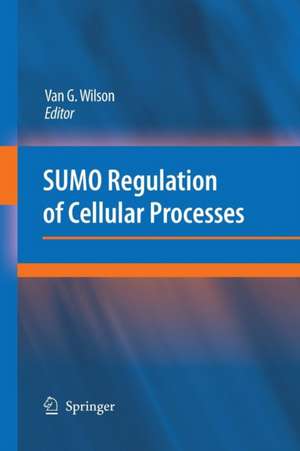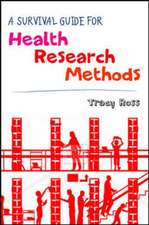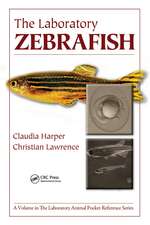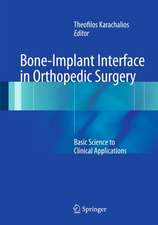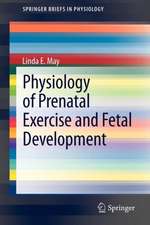SUMO Regulation of Cellular Processes
Editat de Van G. Wilsonen Limba Engleză Paperback – 12 noi 2014
| Toate formatele și edițiile | Preț | Express |
|---|---|---|
| Paperback (2) | 1296.12 lei 6-8 săpt. | |
| Springer International Publishing – 20 iun 2018 | 1296.12 lei 6-8 săpt. | |
| SPRINGER NETHERLANDS – 12 noi 2014 | 1547.14 lei 38-44 zile | |
| Hardback (1) | 1304.91 lei 6-8 săpt. | |
| Springer International Publishing – 24 feb 2017 | 1304.91 lei 6-8 săpt. |
Preț: 1547.14 lei
Preț vechi: 1628.57 lei
-5% Nou
Puncte Express: 2321
Preț estimativ în valută:
296.08€ • 321.50$ • 248.71£
296.08€ • 321.50$ • 248.71£
Carte tipărită la comandă
Livrare economică 19-25 aprilie
Preluare comenzi: 021 569.72.76
Specificații
ISBN-13: 9789400791442
ISBN-10: 9400791445
Pagini: 352
Dimensiuni: 155 x 235 x 18 mm
Greutate: 0.49 kg
Ediția:2009
Editura: SPRINGER NETHERLANDS
Colecția Springer
Locul publicării:Dordrecht, Netherlands
ISBN-10: 9400791445
Pagini: 352
Dimensiuni: 155 x 235 x 18 mm
Greutate: 0.49 kg
Ediția:2009
Editura: SPRINGER NETHERLANDS
Colecția Springer
Locul publicării:Dordrecht, Netherlands
Public țintă
ResearchDescriere
Over
a
decade
ago,
a
small
cellular
protein
of
12
kDa,
with
18%
homology
to
the
well-known
ubiquitin
protein,
was
co-discovered
and
termed
Small
Ubiquitin-like
Modifier,
or
SUMO.
Sumoylation
is
a
post-translational
modification
that
utilizes
SUMO
as
the
modifier
group
covalently
attached
to
target
substrates.
This
state-of-the
art
review
on
the
sumoylation
system
deals
with
protein
modification
as
it
pertains
to
regulation
of
diverse
cellular
functions.
Each
chapter
has
been
written
by
a
leading
researcher
and
covers
the
role
of
sumoylation
in
fundamental
biochemical
activities
(transcription,
RNA
processing,
chromatin
remodelling,
DNA
repair,
nucleocytoplasmic
transport,
ion
channel
regulation,
and
metabolic
pathways).
The
text
also
examines
the
part
sumoylation
plays
in
critical
cellular
processes
such
as
mitosis,
meiosis,
differentiation,
senescence,
and
apoptosis.
Lastly,
the
emerging
role
of
sumoylation
in
specific
diseases,
including
cancer
and
diabetes
as
well
as
neurodegenerative
ones,
is
explored
with
an
emphasis
on
defining
molecular
mechanisms
that
may
provide
new
targets
for
treatment
or
prevention.
While
SUMO
was
discovered
more
than
10
years
ago,
this
is
still
a
relatively
young
field,
and
much
remains
to
be
discovered
about
the
biochemical
and
biological
properties
of
this
modification
system.
In
just
the
last
few
years,
it
has
become
clear
that
sumoylation
modifies
hundreds
of
cellular
proteins,
and
there
has
been
increased
appreciation
for
the
breadth
of
cellular
functions
that
are
impacted
by
this
post-translational
modification.
Cuprins
Chapter
1:
Introduction
to
Sumoylation
Molecular
Functions
Chapter
2:
SUMO
Modification
and
Transcriptional
Regulation
Chapter
3:
Emerging
Roles
for
SUMO
in
mRNA
Processing
and
Metabolism
Chapter
4:
SUMO
and
Chromatin
Remodeling
Chapter
5:
Functions
of
SUMO
in
the
Maintenance
of
Genome
Stability
Chapter
6:
SUMO
and
Nucleocytoplasmic
TransportChapter
7:
SUMO
Modification
of
Ion
ChannelsChapter
8:
The
Role
of
Sumolyation
in
Metabolic
Regulation
Cell
Growth
Regulation
Chapter
9:
The
SUMO
Pathway
in
Mitosis
Chapter
10:
Wrestling
with
Chromosomes:
The
Roles
SUMO
during
Meiosis
Chapter
11:
Sumoylation
in
Development
and
Differentiation
Chapter
12:
The
Role
of
Sumoylation
in
Senescence
Chapter
13:
Sumoylation
and
Apoptosis
Diseases
Chapter
14:
The
Role
of
Sumoylation
in
Neurodegenerative
Diseases
Chapter
15:
Sumoylation
and
its
Contribution
to
Cancer
Chapter
16:
SUMO4-encoded
Genetic
Susceptibility
to
Type
1
Diabetes
Chapter
17:
Sumoylation
in
Craniofacial
Disorders
Chapter
18:
Viral
Interplay
with
the
Host
Sumoylation
System
Textul de pe ultima copertă
Over
a
decade
ago,
a
small
cellular
protein
of
12
kDa,
with
18%
homology
to
the
well-known
ubiquitin
protein,
was
co-discovered
and
termed
Small
Ubiquitin-like
Modifier,
or
SUMO.
Sumoylation
is
a
post-translational
modification
that
utilizes
SUMO
as
the
modifier
group
covalently
attached
to
target
substrates.
This
state-of-the
art
review
on
the
sumoylation
system
deals
with
protein
modification
as
it
pertains
to
regulation
of
diverse
cellular
functions.
Each chapter has been written by a leading researcher and covers the role of sumoylation in fundamental biochemical activities (transcription, RNA processing, chromatin remodelling, DNA repair, nucleocytoplasmic transport, ion channel regulation, and metabolic pathways). The text also examines the part sumoylation plays in critical cellular processes such as mitosis, meiosis, differentiation, senescence, and apoptosis. Lastly, the emerging role of sumoylation in specific diseases, including cancer and diabetes as well as neurodegenerative ones, is explored with an emphasis on defining molecular mechanisms that may provide new targets for treatment or prevention.
While SUMO was discovered more than 10 years ago, this is still a relatively young field, and much remains to be discovered about the biochemical and biological properties of this modification system. In just the last few years, it has become clear that sumoylation modifies hundreds of cellular proteins, and there has been increased appreciation for the breadth of cellular functions that are impacted by this post-translational modification.
Each chapter has been written by a leading researcher and covers the role of sumoylation in fundamental biochemical activities (transcription, RNA processing, chromatin remodelling, DNA repair, nucleocytoplasmic transport, ion channel regulation, and metabolic pathways). The text also examines the part sumoylation plays in critical cellular processes such as mitosis, meiosis, differentiation, senescence, and apoptosis. Lastly, the emerging role of sumoylation in specific diseases, including cancer and diabetes as well as neurodegenerative ones, is explored with an emphasis on defining molecular mechanisms that may provide new targets for treatment or prevention.
While SUMO was discovered more than 10 years ago, this is still a relatively young field, and much remains to be discovered about the biochemical and biological properties of this modification system. In just the last few years, it has become clear that sumoylation modifies hundreds of cellular proteins, and there has been increased appreciation for the breadth of cellular functions that are impacted by this post-translational modification.
Caracteristici
State
of
the
art,
in-depth
review
of
sumoylation
International experts have prepared each chapter
Sumoylation is an essential and critical process that is critical for cell growth and survival
No other available book covers this subject
International experts have prepared each chapter
Sumoylation is an essential and critical process that is critical for cell growth and survival
No other available book covers this subject
